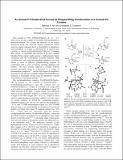An Unusual P-P Double Bond Formed via Phospha-Wittig Transformation of a Terminal PO Complex
Author(s)
Piro, Nicholas A.; Cummins, Christopher C.
DownloadRevised.pdf (465.4Kb)
PUBLISHER_POLICY
Publisher Policy
Article is made available in accordance with the publisher's policy and may be subject to US copyright law. Please refer to the publisher's site for terms of use.
Terms of use
Metadata
Show full item recordAbstract
The terminal phosphorus monoxide complex [(OP)Mo(N[superscript t Bu]Ar) subscript 3], 1 (Ar = 3,5-Me2C6H3) [1 (Ar = 3,5-Me subscript 2 C subscript 6 H subscript 3)], undergoes an O-for-PSiR3 [O-for-PSiR subscript 3] metathesis reaction with the niobium phosphinidene complex iPr3SiPNb(N[CH2tBu]Ar)3 [superscript i Pr subscript 3 SiPNb(N[CH subscript 2 superscript t Bu]Ar) subscript 3], 2, to generate the oxoniobium complex ONb(N[CH2tBu]Ar)3 [ONb(N[CH subscript 2 superscript t Bu]Ar) subscript 3], 3, and the diphosphenido complex iPr3SiPPMo(N[tBu]Ar)3 [superscript i Pr subscript 3 SiPPMo(N[superscript t Bu]Ar) subscript 3], 4. The structure of 4, as determined by X-ray crystallography, contains a “singly bent” diphosphenido moiety, suggesting that the diphosphenido ligand serves as a 3e− donor to a formally d2 [d superscript 2] metal center. This bonding characterization was supported by DFT calculations and is unique among known diphosphenido complexes. Diphosphenido 4 was found to react over time to produce products consistent with a bimolecular degradation pathway where the terminal phosphide complex [PMo(N[superscript t Bu]Ar) subscript 3], 5, serves as a stable leaving group. Mixtures of 4 and PPh3 [PPh subscript 3] were observed to set up an equilibrium (Keq = 0.7) [(K subscript eq = 0.7)] between 4, PPh3 [PPh subscript 3], and the products of phosphinidene transfer, 5 and iPr3SiP═PPh3 [superscript i Pr subscript 3 SiP═PPh subscript 3].
Date issued
2009-06Department
Massachusetts Institute of Technology. Department of ChemistryJournal
Journal of the American Chemical Society
Publisher
American Chemical Society
Citation
Piro, Nicholas A., and Christopher C. Cummins. “An Unusual P−P Double Bond Formed via Phospha-Wittig Transformation of a Terminal PO Complex.” Journal of the American Chemical Society 131.25 (2009) : 8764-8765. Copyright © 2009 American Chemical Society
Version: Author's final manuscript
ISSN
0002-7863
1520-5126